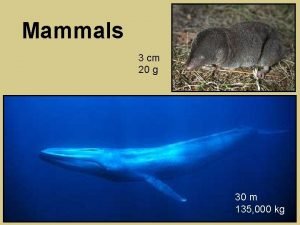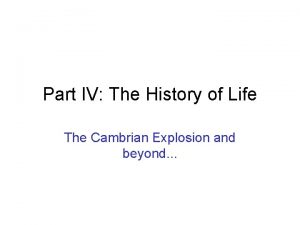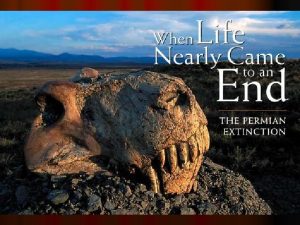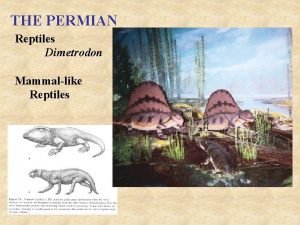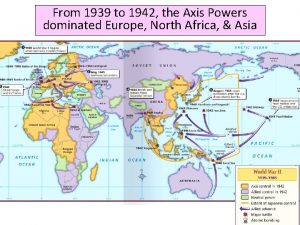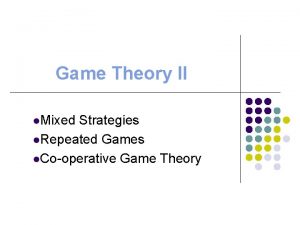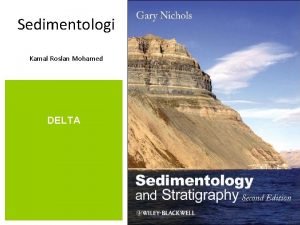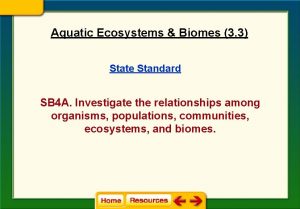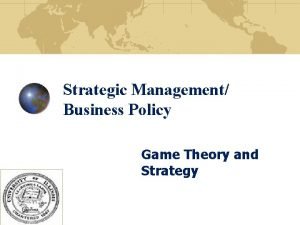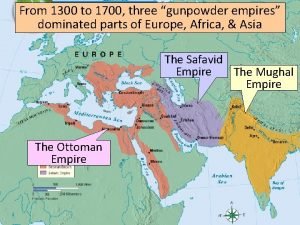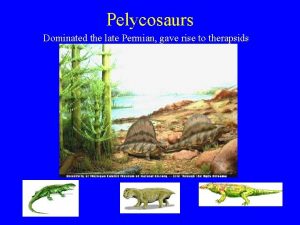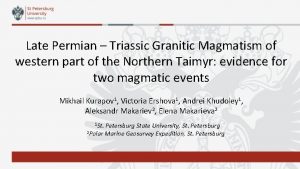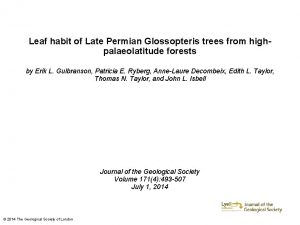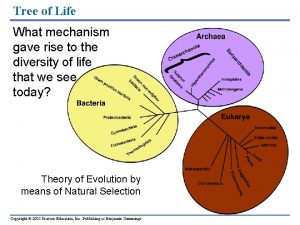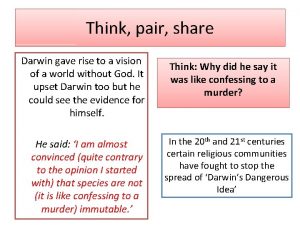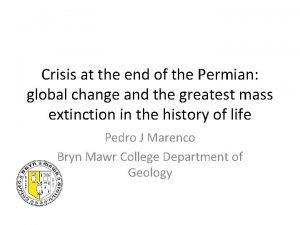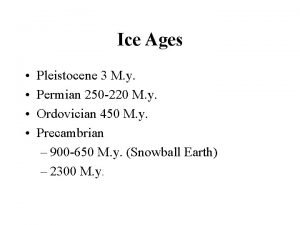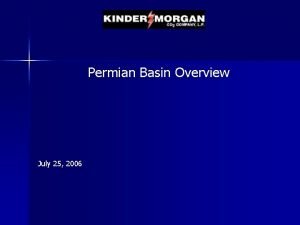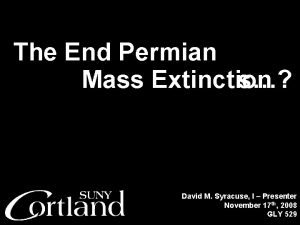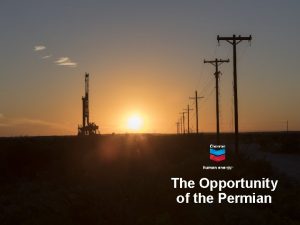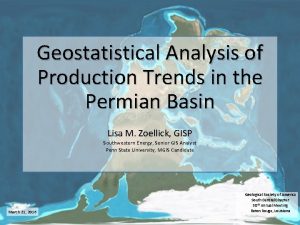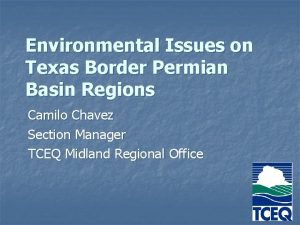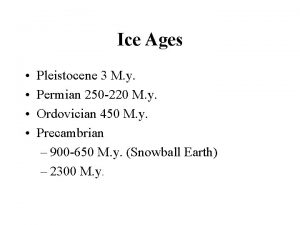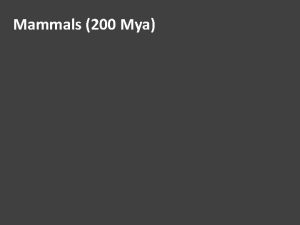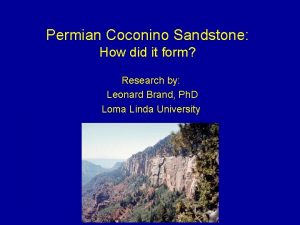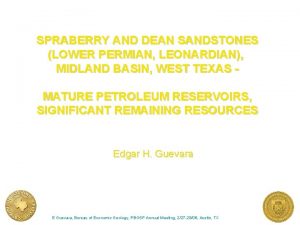Pelycosaurs Dominated the late Permian gave rise to



























- Slides: 27

Pelycosaurs Dominated the late Permian, gave rise to therapsids

Therapsids Rapid radiation in late Permian, around 270 MYA Still “mammal-like reptiles”

Cynodonts Late Permian to mid Triassic Last remaining group of therapsids, survived mass extinction at the end of the Permian. Persisted well into Triassic and developed many features associated with mammals. Only 1 lineage of cynodonts survived through the late Triassic, and this group became ancestors of mammals

Mesozoic: the Dark Age for Mammals! multituberculate Morganucodon, one of the earliest mammals Most were very small

. . . but new fossil finds indicate more diversity than we thought, at least in the later Mesozoic Still, largest known mammal during Mesozic is no larger than a woodchuck Most were shrew to mouse sized, for 125 million years!

Bye-bye dinos!

Hello mammalian radiation! Monotremes Marsupials Eutherians (placental mammals) Eomaia Sinodelphys

Not just a steady increase in diversity over time. . . Earth’s history helped shape the evolution of vertebrates, especially mammals. Positions of the continents affected climate, formation of habitat types, and the ability of organisms to disperse among regions.

Continental drift played a key role in mammalian evolution Late Paleozoic and early Mesozoic: continuity of Pangaea allowed tetrapods to move freely across land areas. By late Mesozoic, Pangaea breaking up, shallow seas across centers of many continents, southern continents separating both from northern continents and each other. Cretaceous: Gondwana split up, but retains some southern connections.

Eocene: S Am and Antarctica still have some connection, Ant. moving over pole, ice sheets form late Eocene -Oligocene Eocene Miocene: cooling and drying, Arctic ice sheets forming by late Miocene

Paleotemperatures (see handout) First half of Cenozoic fairly warm, modern climate cooler

Brief summary of ecosystem changes: 1. Early Cenozoic (Paleocene, Eocene) was warm world with tropical-like forests even at high latitudes. Exceptionally broadleaved forests above arctic circle and in Patagonia. . . tolerate long periods of low light in “winter” but no frost? 2. Global cooling in Oligocene. Temperate forests and woodlands replace tropical-like forests at higher latitudes. Tropical forests now more equatorial. 3. Miocene: Extensive grasslands and savannas form in N Am and Asia (earlier in S Am). . . new kind of major habitat. Mountain ranges building in Miocene and Pliocene contribute to formation of arid regions (grasslands, steppes, deserts). 4. Pleistocene ice ages

Ptilodus - multituberculate Paleocene forest Chriacus – small climber Diatryma Phenacodus – sheep-sized herbivore/omnivore

Eocene scenes Andrewsarchus Icaronycteris Basilosaurus

Prorastomus – early sirenian Andrewsarchus – largest terrestrial predator Paleotherium – primitive perissodactyl Eobasilus - uintathere Moeritherium – elephant ancestor

Indricotherium Arsinotherium Archeotherium - entelodon chalicothere Oligocene. . . some big stuff Brontotherium Mesohippus

Views of the Miocene Some still like Oligocene Epigaulus – horned rodent

Pleistocene megafauna

Marsupials, and Australia 1. Marsupials: odd modern distribution baffled biogeographers until discovery of continental drift. 2. Oldest fossils from early Cretaceous in central Asia, spread to N Am where diverse and common in late Cretaceous 3. Spread to S Am by late Cretaceous, southern dispersal through Antarctica to Australia by Eocene (fossils in Antarctica) 4. By Miocene, extinct in N Am, Europe, Asia (possibly in Oligocene in Asia) 5. Southern continents separate by late Eocene, Antarctica become polar, polar current develops, ice sheets 6. Australia basically an island continent from Oligocene to Recent, only monotremes and marsupials. . . a few placental rodents and bats appear in Miocene as nears SE Asia 7. But neat diversification of marsupials in Australia! (see HO)

Thylacoleo Procoptodon Diprotodon

South America – also an “island” 1. At time of isolation from Africa and N Am, early Paleocene fossils included: 2. - primitive marsupials (opossum-like) 3. - xenarthrans: unique to S Am, now anteaters, sloths, armadillos 4. - variety of primitive condylarths (ungulate types) 5. - NO early placental carnivores like creodonts (group that became carnivores in Laurasia at this time) 6. 2. Archaic mammals radiated in isolation in S Am 7. - xenarthrans basically omnivores and folivores (giant ground sloths, glyptodonts) 8. - herbivore niches mostly filled by primitive condylarths (horse-like Litopterns, bulky Notoungulates) 9. - carnivore niches filled by marsupials (Thylacosmilids = sabretooth “cats”, Borhyaenids = dog and bear-like groups 10. - plus some unique S Am forms of marsupials (bipedal Argyrolagids, burrowing Necrolestids)

Thylacosmilus Megatherium and 2 Glyptodons Borhyaena Macrauchenia Miocene, horse-like litopterns

scale for glyptodont giant ground sloth = 12 ft tall Argyrolagus

History of South America 1. Radiation in isolation (Paleocene, Eocene) 2. Early “island hoppers”: monkeys and histricognath rodents arrive from Africa (late Eocene - Oligocene) 3. Early dispersers from the north: “newer” murid rodents and raccoons (late Miocene – Pliocene) 4. Great American Interchange after connection via Panamian isthmus Families Origin Just before N Am During Just after S Am N Am 25 0 25 13 20 10 S Am 2 26 14 16

What about the rest of the world? 1. Oldest split among eutherians (placental mammals) is a group that originated in Africa: now called Afrotherians (elephants, hyraxes, aardvark, sirenians, golden moles, tenrecs, elephant shrews) 2. Next split was xenarthrans, only found in S Am: sloths, anteaters, armadillos 3. Remaining eutherian mammals all have origins in Laurasia, called Boreoeutherians 4. Boreoeuthreians split into several clades, leading to most modern mammals (see handout)

Modern biogeography will be covered later. . . 1. N Am and Eurasia maintained high levels of dispersal, especially across Beringia, and share much of their northern mammal faunas (filter bridge. . . northern species did the most dispersing across northern land bridges, called the “Holarctic” fauna) 2. India didn’t have much by the time is became an island, was colonized only after colliding with Asia 3. Africa was mostly separated from Laurasia by the Tethys Sea by the late Cretaceous, and become more or less isolated like the other Gondwanan fragments. Afrotheria became distinct in Africa after this time. 4. By late Eocene or early Oligocene, Africa became “inoculated” with other types of mammals from the northern continents, as proximity to Laurasia (esp. Arabian area) developed. In Oligocene, Miocene, and Pliocene, lots of mixing with Laurasia, but through another filter bridge (narrow routes, often desertified). Thus, many modern African mammals bear close affinities with Laurasian taxa, but with high endemism at the genus and species levels. Africa gave the northern continents elephants!

The end
 Pelycosaurs
Pelycosaurs Pelycosaurs
Pelycosaurs Permian extinction
Permian extinction Monophyletic group
Monophyletic group The great dying
The great dying Transgression
Transgression Permian basin pipeliners association
Permian basin pipeliners association Rise and rise again
Rise and rise again Tricky dick
Tricky dick Rise and rise again until lambs become lions
Rise and rise again until lambs become lions Rise and rise again until lambs become lions origin
Rise and rise again until lambs become lions origin Who dominated europe, north africa and asia from 1939-1942?
Who dominated europe, north africa and asia from 1939-1942? Pure strategy game theory
Pure strategy game theory River dominated delta
River dominated delta Napoleon's relatives ruled
Napoleon's relatives ruled Rise of greek civilization
Rise of greek civilization Biome sb
Biome sb One seller complete barriers to market entry
One seller complete barriers to market entry Business policy game
Business policy game Napoleon bonaparte dominated
Napoleon bonaparte dominated “gunpowder empires” dominated
“gunpowder empires” dominated Consumer decision making process
Consumer decision making process What is teacher dominated approach
What is teacher dominated approach Revenue dominated cash flow
Revenue dominated cash flow Marine ecosystem dominated by marsh grasses
Marine ecosystem dominated by marsh grasses Hello market
Hello market đại từ thay thế
đại từ thay thế Vẽ hình chiếu vuông góc của vật thể sau
Vẽ hình chiếu vuông góc của vật thể sau
